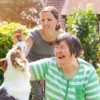The Oxford English Dictionary defines anxiety as “a feeling of worry, nervousness, or unease, typically about an imminent event or something with an uncertain outcome.”
Anxiety is the body’s natural response to stress. It will manifest differently in different children. Some young people will experience bouts of anxiety accompanied by severe and/ or prolonged symptoms, while others may experience mild, and/ or fleeting symptoms of anxiety.
Adolescents that experience persistent and debilitating anxiety may have an anxiety disorder. The National Alliance on Mental Illness (NAMI) asserts: “Anxiety disorders are a group of related conditions, each having unique symptoms. However, all anxiety disorders have one thing in common: persistent, excessive fear or worry in situations that are not threatening.” The exact cause for developing an anxiety disorder remains unknown. Research suggests that it is likely due to a combination of contributing factors such as psychological, environmental, genetic, and developmental factors. The different types of anxiety disorders listed in the Diagnostic and Statistical Manual of Mental Disorders, Fifth Edition (DSM-5) and their respective prevalence within the adolescent population include:
- Generalized anxiety disorder (GAD): characterized by severe ongoing anxiety and exaggerated worry and tension (even when there is little or nothing to provoke it) that interferes with daily activities. Data reported in the 2017 National Comorbidity Survey Adolescent Supplement (NCS-A) estimates approximately 2.2% of young people between the ages of 13-18 had generalized anxiety disorder.
- Obsessive-compulsive disorder (OCD): characterized by intrusive, unreasonable thoughts and/ or fears (obsessions) that commonly lead to compulsive, repetitive behaviors (compulsions). OCD is one of the more common mental illnesses of children and adolescents, with a prevalence of 1% to 3%.
- Panic disorder: characterized by the sudden onset of recurring panic attacks that occur spontaneously and without cause. An estimated 2.3% of adolescents meet the diagnostic criteria for panic disorder.
- Post-traumatic stress disorder (PTSD): characterized by symptoms of avoidance and nervous system arousal after experiencing or witnessing a traumatic event. Results from the National Comorbidity Survey Replication- Adolescent Supplement, which includes a nationally representative sample of over 10,000 adolescents aged 13-18, indicates that PTSD affects roughly 5% of adolescents.
- Social anxiety disorder (social phobia): characterized by severe feelings of self-consciousness and insecurity in social settings. Social anxiety disorder is estimated to affect 9.1% of children in America.
- Separation anxiety disorder: characterized by an exaggeration of otherwise developmentally normal anxiety manifested by excessive concern, worry, and even dread of the real or anticipated separation from an attachment figure. Researchers estimate that childhood separation anxiety disorder is prevalent in approximately 1-4% of the general pediatric population.
Further Information and Support
For most of us, life can be very stressful, leading us to feel emotionally charged, which can cause anxiety, panic attacks, depression, and getting stuck in a cycle of being burdened with negative thoughts. Navigating through the challenges and emotional turmoil of life can be overwhelming, but you do not have to go through it alone. Engage Treatment is a Joint Commission Accredited professional psychological practice. We specialize in treating children, teens, and young adults struggling with depression and anxiety through community-focused treatment plans that incorporate a carefully selected combination of therapeutic interventions. Our compassionate, multidisciplinary practitioners are devoted to providing the highest quality of care that helps ignite positive change and enables clients to reach optimal health and well-being. Please do not hesitate to reach out for guidance. We are happy to answer questions and provide you with any additional information. Feel free to call us at 805-497-0605 or email us at [email protected]. You are also welcomed to get in touch by filling out our contact form. We look forward to connecting and having the opportunity to discuss how we might best be able to support you.
Contact Us
Westlake Campus:
IOP Program
2625 Townsgate Road, Suite 210
Westlake Village, California 91361
Agoura Campus:
Private Therapy & Parenting Program
30300 Agoura Road, Suite 250
Agoura Hills, CA 91301
805-497-0605
805-371-4862











© 2023 Engage Treatment Program, Inc. All Rights Reserved.
LGBTQ Friendly
About
• About Engage
• Our Team
• Career Opportunities
• Individual / Family Therapy






